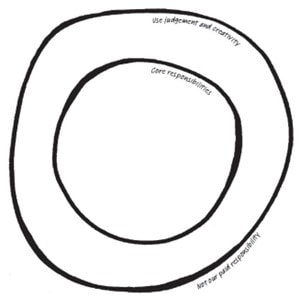
With so many organizations hiring new staff, we are reminded that a new team member and their manager or supervisor can use the person-centered thinking skill, the donut, during supervision to facilitate discussions on roles and responsibilities listed in the position description. It can be used to reach a shared understanding of what each responsibility means at a practical level within the staff member’s role.
Even with a very clear job description, once a staff member is in their role, elements often need fleshing out or require further discussion to ensure the staff member is confident in what is expected of them.
For example, a team leader raised an issue in a supervision session concerning an individual she worked with.
Part of her role was to support him with his diabetes management plan, but he often chose not to follow the plan. The support worker was concerned and unsure what to do.
Her manager used the donut to clarify her role around this, so that she would be able to develop new strategies based on who the individual was and his support needs.
The staff member is now clear about the balance between duty of care and dignity of risk, while still knowing what is expected from her in her role.
The donut is a working document and can be used flexibly during supervision to clarify a staff member’s role and responsibilities. Additional information can be added as needed.
Core responsibilities should link to the strategic core requirements, functional requirements and key performance measures in the staff member’s position description. Use the donut as a starting point to clarify how the position description applies to specific day-to-day expectations.
Be clear and specific. You cannot provide clarity if something is open to interpretation by the manager, supervisor and/or the staff member; it is also difficult to hold someone to account if they don’t know what is expected of them.
A staff member might have a performance measure in their position description stating – shares knowledge and information.
Using the donut to agree and clarify core responsibilities will result in an agreement or understanding on how, when, how often and with whom this applies. For example:
‘Shares new learning and ideas about individuals you work with by:
If a staff member is struggling with a particular situation or aspect of their work, use the heading of core responsibility to support them to think through their role rather than just telling them what to do.
Use the creativity and judgement section to encourage the staff member to try new and different ways of doing things. Explore areas detailed in the core responsibilities where, as long as they do the work required, there is no right or wrong way of approaching it.
In this situation the staff member is responsible for maintaining regular contact with an individual’s family.
Their core responsibility might be to communicate with the family once a month. In using the creativity and judgement section of the donut, the staff member might focus on how and when they approach this, depending on the family’s preference and based on how it works best for all involved. This provides clear expectations without being prescriptive.
This section captures the point at which the staff member is no longer accountable. It also assists managers and supervisors to clarify what is expected if there is a risk that they may ‘cross a line’ in their role.
This can also be used to specify the point at which the staff member’s role ends and someone else’s begins. This is particularly useful when someone is starting to take on responsibility that is not required of them.
Using the donut works for everyone involved. It enables a manager or supervisor to ensure their staff are accountable within their role. It also assists the staff member in feeling clearer and more confident about what is expected of them.
This article is reprinted from resources developed by National Disability Services Ltd, and Helen Sanderson Associates. The donut is one of several person-centered thinking skills developed by the Learning Community for Person Centered Practices
There was a problem reporting this post.
Please confirm you want to block this member.
You will no longer be able to:
Please note: This action will also remove this member from your connections and send a report to the site admin. Please allow a few minutes for this process to complete.